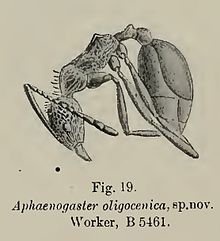Aphaenogaster oligocenica
| Aphaenogaster oligocenica Temporal range:
| |
|---|---|

| |
| A. oligocenica holotype illustration | |
| Scientific classification | |
| Domain: | Eukaryota |
| Kingdom: | Animalia |
| Phylum: | Arthropoda |
| Class: | Insecta |
| Order: | Hymenoptera |
| Family: | Formicidae |
| Subfamily: | Myrmicinae |
| Genus: | Aphaenogaster |
| Species: | A. oligocenica
|
| Binomial name | |
| Aphaenogaster oligocenica Wheeler, 1915
| |
Aphaenogaster oligocenica is an
Middle Eocene fossils found in Europe. A. oligocenica is one of three species in the ant genus Aphaenogaster to have been noted from fossils found in Baltic amber by William Morton Wheeler.[1]
History and classification
When first examined, Aphaenogaster oligocenica was described from a single
Middle Eocene. There is debate over the plant family which produced the amber, with evidence supporting relatives of either an Agathis or a Pseudolarix.[2] When first described, the type worker was part of the University of Königsberg amber collection as specimen number B5461, and the possible second fossil was specimen number B18570. The fossils were first studied by Wheeler, then a paleoentomologist with Harvard University, who placed the species in the genus Aphaenogaster. Wheeler's 1915 type description of the new species was published in the journal Schriften der Physikalisch-Okonomischen Gesellschaft zu Konigsberg.[1]
In his 1915 paper Wheeler noted that alongside A. oligocenica, two other Aphaenogaster species are known from European amber fossils Bitterfeld amber, A. mersa has only been found in Baltic amber and A. antiqua in Rovno amber.[3]
Description
The type worker of A. oligocenica has an approximate body length of 4.5 millimetres (0.18 in), with a large
epinotum the striations are well pronounced and placed further apart than those on the head.[1]
References
Wikimedia Commons has media related to Aphaenogaster oligocenica.
- ^ a b c d e Wheeler, W. M. (1915). "The ants of the Baltic amber". Schriften der Physikalisch-Okonomischen Gesellschaft zu Konigsberg. 55 (4): 56–59.
- ^ Henderickx, H.; Tafforeau, P.; Soriano, C (2012). "Phase-contrast synchrotron microtomography reveals the morphology of a partially visible new Pseudogarypus in Baltic amber (Pseudoscorpiones: Pseudogarypidae)". Palaeontologia Electronica. 15 (2, 17A, 11p): 1–11.
- ^ S2CID 84191149.
